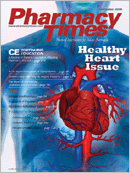Publication
Article
Pharmacy Times
Let's "Iron" Out the Problem
Author(s):
The Problem
A mother whose daughter received anoverdose of an oral iron product becauseof her difficulty understanding OTC ironsupplement labels contacted theInstitute for Safe Medication Practices.The mother was confused about the relationshipbetween ferrous sulfate and elementaliron, each of which appeared onthe label. She explained that she spentover an hour trying to figure out howmuch her daughter was receiving beforeshe realized her child was receiving morethan prescribed. Similar reports frompatients and health professionals indicatethat confusion is not uncommon.
Unfortunately, manufacturers have nostandardized way to express thestrength on the front panel of cartons.AsOTC dietary supplements, iron productsare regulated by the FDA's Center forFood Safety and Applied Nutrition(CFSAN). Regulations require a "commonor usual name" of the product on thefront panel. This allows manufacturers tolabel their products as "Iron" and expressthe strength in terms of elemental iron(eg, Iron 65 mg), as the salt form (eg,Ferrous Sulfate 325 mg), or in ways thatmake it difficult to interpret whether thesalt form or elemental iron strength isindicated. Wording that the product is a"dietary supplement" or "iron supplement"also must be on the label. Finally,the "Supplement Facts" portion of theproduct label must indicate the amountof "iron," which, according to a CFSANrepresentative, means elemental iron,contained in each dosage unit.
Unlike the information presented inthe "Supplement Facts," prescribersoften communicate doses for iron supplementsin terms of the salt form, not aselemental iron, which contributes to confusion.Thus, if a prescriber tells a patientto take 325 mg of ferrous sulfate or 325mg of "iron," patients may read theamount of elemental iron and figure theyneed to take 5 tablets (5 x 65 mg = 325mg) for each dose. We have even heardfrom practitioners who have similarlymisinterpreted iron supplement labels.For example, after receiving a productlabeled "Iron (as ferrous sulfate) 65 mg,"a nurse in a skilled nursing facility calculatedthat 5 tablets were needed for asingle dose of ferrous sulfate 325 mg.Fortunately, she realized that 5 tabletsper dose seemed odd, and a call to thefacility's pharmacist helped prevent aserious error. Who knows how manyerrors may go undetected, though—leading to patients receiving unintendedamounts of elemental iron.
Safe Practice Recommendations
Since most iron supplements are availableover the counter, patients may purchaseproducts in any number of places,including the pharmacy, without a pharmacist'sassistance. In order to minimizethe likelihood of errors with iron supplements,consider the following:
•Ideally, all dosages should beexpressed in terms of milligrams ofelemental iron. Because prescribersoften express doses interms of the ferrous salt form, however,while some package labelingindicates strength in terms of elementaliron, both should appear inall forms of communication (eg,prescriptions, pharmacy labels,manufacturer labels, drug references)—for example, ferrous sulfate325 mg (elemental iron 65 mg).
•Ensure that package labels clearlyexpress iron dosages. If unclear,provide a pharmacy label withproper patient instructions.
•Verify that the selected dosage fallswithin the guidelines for ironreplacement therapy for thepatient's age and weight
•Store iron supplements behind thepharmacy counter, and require apharmacist to provide counselingregarding dosing instructions. If thisis not possible, place products nearthe pharmacy checkout in plainview of the pharmacist to capturean important counseling opportunity.At minimum, use "shelf talkers"near these products that instructpatients to ask for a pharmacist'shelp when selecting iron supplements.
•Educate staff and patients thatiron-containing products are availablein salt forms such as ferrousgluconate, sulfate, and fumarate.Emphasize the difference betweenelemental iron and its salt forms.
•Stress the importance of keepingthese products out of the reach ofchildren. If an accidental ingestionoccurs, recommend contacting thenearest poison control center (800-222-1222) immediately.
Dr. Gaunt is a medication safetyanalyst and the editor of ISMPMedication Safety Alert!Community/Ambulatory CareEdition.
Subscribe to Newsletter
Pharmacy Times and the Institute for SafeMedication Practices (ISMP) would like to makecommunity pharmacy practitioners aware of apublication that is available.
The ISMP Medication Safety Alert! Community/Ambulatory Care Edition is a monthly compilationof medication-related incidents, error-preventionrecommendations, news, and editorial content designedto inform and alert community pharmacypractitioners to potentially hazardous situationsthat may affect patient safety. Individual subscriptionprices are $45 per year for 12 monthlyissues. Discounts are available for organizationswith multiple pharmacy sites. This newsletter isdelivered electronically. For more information, contactISMP at 215-947-7797, or send an e-mailmessage to [email protected].







